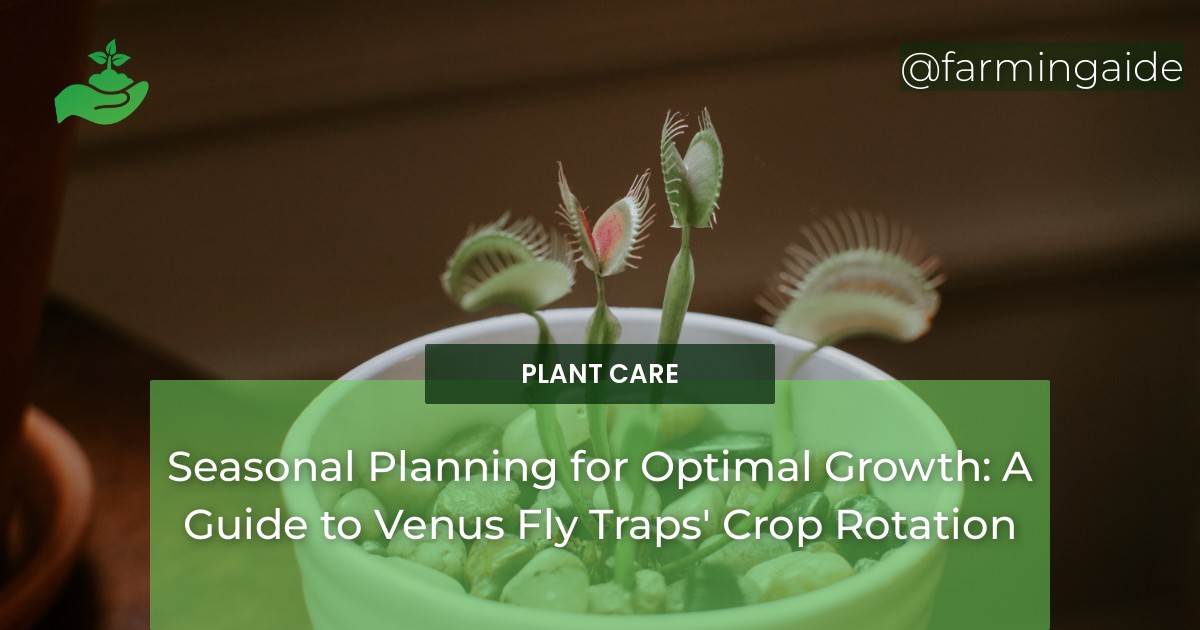Welcome to the world of urban farming and horticulture, where the art of growing plants and crops in an urban setting has become increasingly popular. As an expert in both SEO and the urban farming and horticulture industry, I am excited to share with you my knowledge on a crucial aspect of plant growth – seasonal planning and crop rotation. In this comprehensive guide, we will delve into the world of Venus Fly Traps and explore the importance of crop rotation for their optimal growth. By the end of this article, you will have a thorough understanding of how to plan and implement crop rotation for Venus Fly Traps, as well as tips for maximizing growth and preventing disease. So let’s get started!
The Importance of Rotating Venus Fly Traps’ Crops
Before we dive into the specifics of crop rotation for Venus Fly Traps, let’s first understand why it is important. Crop rotation is the practice of growing different crops in the same area in sequential seasons. This is crucial for maintaining healthy plants and maximizing growth, as it helps to prevent the buildup of pests and diseases, and allows for better nutrient uptake.
When it comes to Venus Fly Traps, crop rotation is especially important as these plants have specific nutrient requirements and are prone to certain diseases. By rotating their crops, we can ensure that they have access to the nutrients they need and reduce the risk of disease.
How to Plan and Implement Crop Rotation for Healthy Plants
Now that we understand the importance of crop rotation for Venus Fly Traps, let’s discuss the steps involved in planning and implementing it. The first step is to choose suitable crops for rotation. These should be plants that have different nutrient requirements and are not susceptible to the same diseases as Venus Fly Traps.
Next, it is important to rotate the crops effectively. This means not planting the same crop in the same area for at least two consecutive seasons. It is also important to consider factors such as plant compatibility and soil health when planning crop rotation.
Proper soil management and composting are also crucial for successful crop rotation. This helps to maintain the health of the soil and provide the necessary nutrients for the plants. Regular monitoring of plant health is also important during crop rotation, as it allows for early detection of any issues that may arise.
Tips for Maximizing Growth and Preventing Disease Through Crop Rotation
To ensure the best results for your Venus Fly Traps, here are some specific tips for maximizing growth and preventing disease through crop rotation:
- Rotate crops every 2-3 years to prevent the buildup of pests and diseases.
- Choose companion plants that can help to repel pests and attract beneficial insects.
- Use organic pest control methods, such as neem oil or insecticidal soap, to avoid harmful chemicals.
- Regularly test the soil to ensure it has the necessary nutrients for your plants.
- Rotate crops in a clockwise direction to avoid nutrient depletion in the soil.
Sustainable Gardening Practices for Venus Fly Traps
Sustainable gardening is a holistic approach to gardening that focuses on preserving the environment and promoting biodiversity. Crop rotation is an important aspect of sustainable gardening, as it helps to maintain the health of the soil and reduce the need for chemical fertilizers and pesticides.
In addition to crop rotation, other sustainable practices that can be incorporated into Venus Fly Traps‘ crop rotation include companion planting and organic pest control. These methods not only benefit the plants, but also promote a healthier and more sustainable ecosystem.
Seasonal Planning for Venus Fly Traps’ Crop Rotation
As with any type of gardening, seasonal planning is crucial for successful crop rotation for Venus Fly Traps. Different seasons bring different challenges and opportunities, and it is important to adjust your crop rotation accordingly.
For example, during the growing season, it is important to monitor the plants for any signs of disease or nutrient deficiencies. In the winter, you may need to provide additional protection for your plants from harsh weather conditions. By planning for each season, you can ensure that your Venus Fly Traps have the best chance for optimal growth.
How Does Soil Management and Composting Impact Venus Fly Traps’ Growth and Crop Rotation?
Soil management and composting play a crucial role in the growth of Venus fly traps. By ensuring that the soil is nutrient-rich and well-drained, the plants can thrive and catch their prey effectively. Additionally, incorporating compost into the soil can help maintain the proper pH levels necessary for healthy growth. Crop rotation can also improve soil quality, benefiting the Venus fly trap’s development.
Conclusion
In conclusion, crop rotation is a vital practice for maintaining healthy Venus Fly Traps and maximizing their growth. By following the steps outlined in this guide and incorporating sustainable gardening practices, you can ensure that your Venus Fly Traps thrive in any urban farming or horticulture setting. Remember to rotate crops every 2-3 years, choose suitable companion plants, and regularly monitor plant health for the best results. Happy gardening!


